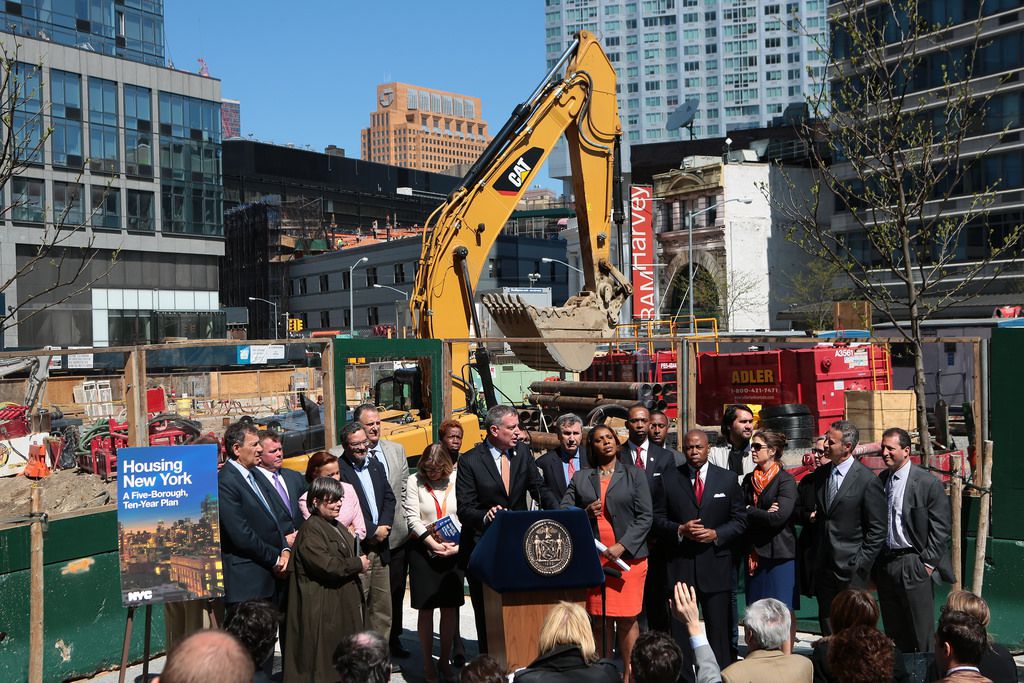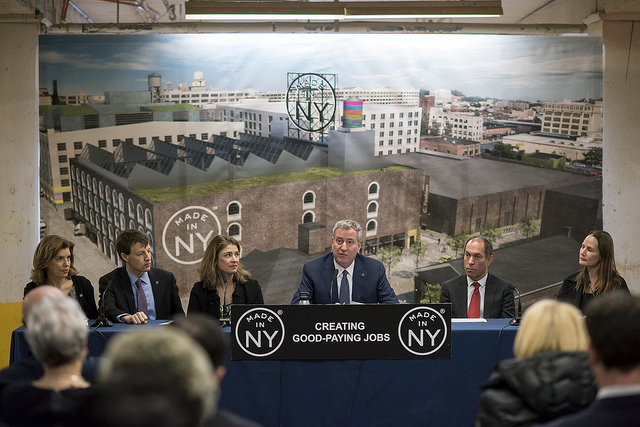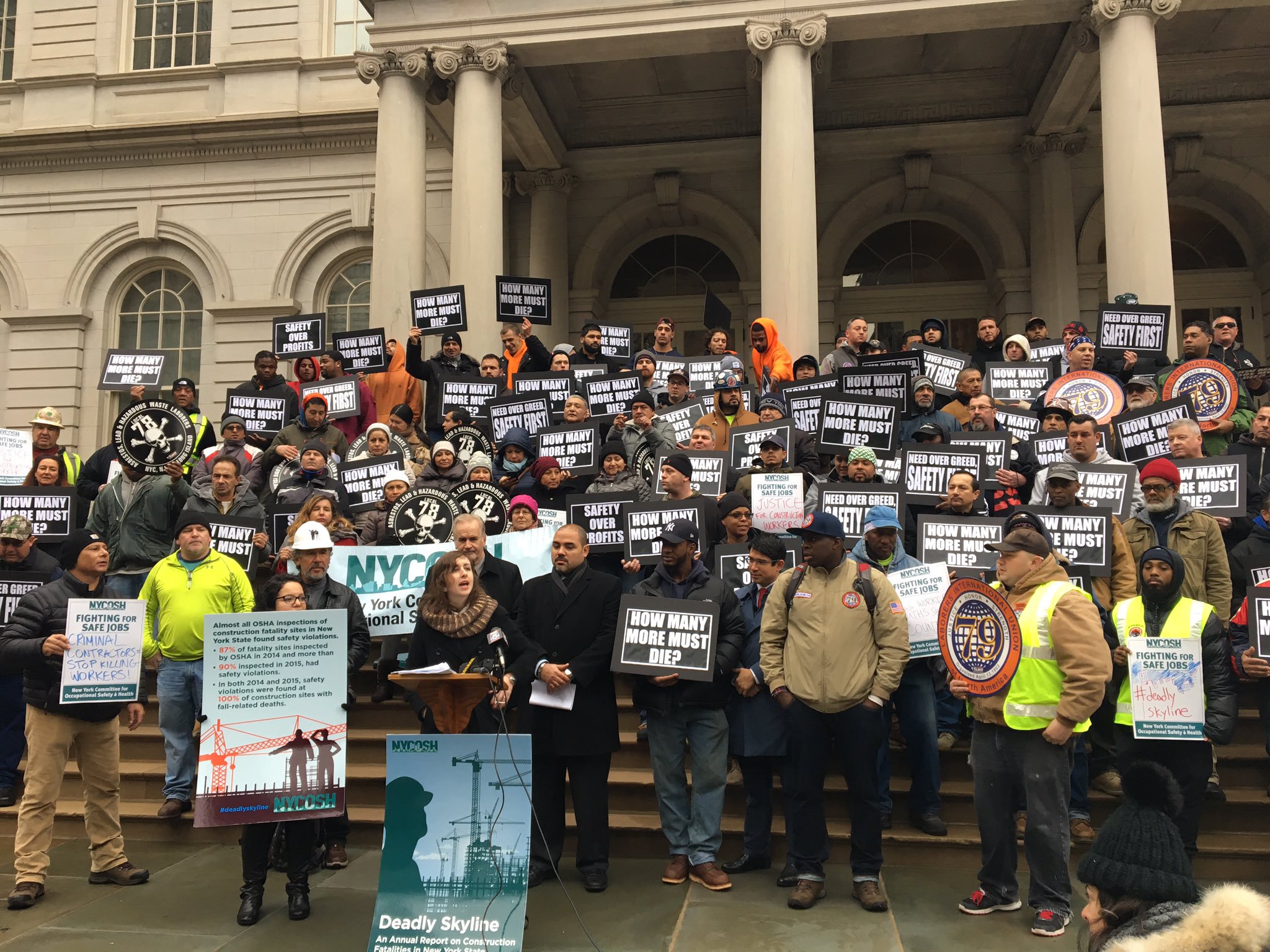Building a New Future for Low-Income New Yorkers

Mayor de Blasio at a ground-breaking (photo: The Mayor's Office on Flickr)
Mayor Bill de Blasio recently announced that he will allocate much-needed additional funds to increase housing opportunities for 10,000 low-income families and seniors citywide. The New York State Association for Affordable Housing (NYSAFAH) commends the mayor on providing nearly $2 billion in new housing subsidy for low-income families, which will further alleviate New York City’s housing crisis by maximizing low-income housing production.
Now it is time to put those resources to work by moving past anti-development attitudes that have distorted the conversation around affordable housing for too long.
Affordable housing builders have – with limited resources – already made important strides to house low-income New Yorkers under Mayor de Blasio’s leadership, with more than 13,000 homes built and preserved for households at or below 50 percent of area median income (AMI).
NYSAFAH and its members have long made it clear that we are prepared to do more for New York’s lowest income families and so have continually advocated for the additional resources necessary to build this housing. Every New Yorker deserves access to safe, quality affordable housing and we will not stop until that mission is accomplished.
To understand the real value of this announcement, we must recognize the previous lack of financial assistance available to build housing for very-low and low-income New Yorkers.
The efforts of affordable housing developers have been hindered by federal, state, and local program provisions under which NYSAFAH’s members can build. Additionally, due to the rising cost of land and construction in New York, it has been nearly impossible to build new housing for the lowest income families without the offset of units for higher-earning households in the low- and middle-income brackets. The mayor’s new subsidy will allow developers to specifically address the needs of those making less than $40,000 per year.
Too often critics of smart development have distorted reality by falsely claiming that developers have purposely not paid enough attention to low-income housing. These critics, backed by politically motivated construction unions, have tried to convince New Yorkers and elected officials that the problem lies with developers rather than to acknowledge the obvious lack of resources required to build much-needed homes. The attacks on affordable housing builders have for a long time ignored the fiscal reality of what is required to support low-income families and maintain their homes with a fixed rental income stream.
Another lesser known fact is that affordable housing developments remain under long-term affordability agreements for 25 years or more, despite the reality of costly changes to market conditions and utilities. With the recognition by Mayor de Blasio that there is need for more subsidy, we can continue to take steps to unlock the full potential of low-income housing development.
We must move beyond the political posturing and rhetoric, and every single stakeholder must work in partnership to positively transform the lives of low-income families across the five boroughs. NYSAFAH members are ready to do just that – and we hope that others will join us in building a better future for every New Yorker.
***
Jolie Milstein is president and CEO of the New York State Association for Affordable Housing (NYSAFAH).
***
Have an op-ed idea or submission for Gotham Gazette? Email This email address is being protected from spambots. You need JavaScript enabled to view it.
Jobs of the Future Come From The Right Education

Mayor Bill de Blasio (photo: Ed Reed/Mayor's Office)
In his State of the City speech last week, Mayor Bill de Blasio spoke of the need to create 100,000 good jobs for New Yorkers in the coming decade. He defined “good jobs” as those which pay more than $50,000 a year and talked about encouraging various sectors of the economy, like technology, that have average salaries that pay even more. To his credit, the mayor talked about creating good jobs that don’t necessarily require a college degree, like construction, but he also recognized the important role advanced education plays in attaining many well-paying technology-based jobs that are at the core of our globalized economy.
I think that’s great, but if the jobs to be created are to be held by New Yorkers – meaning children from every community who are educated in our city’s schools, whether they are native-born or immigrants – his administration must do more to prepare our city’s children for the STEM (Science, Technology, Engineering and Math) jobs of the future.
Sadly, according to a report by the New York City Comptroller’s office, which relied on Department of Education statistics, “only about one-fifth of the City’s new college-degreed entrants to its workforce...are products of the City’s school system.”
Critics of the mayor’s speech suggest that he can do little to actually promote the creation of such jobs for New Yorkers. I disagree. The city needs to spend more money where it will do the most good to prepare our children for the high tech jobs of the future, and that means spending more on STEM education in our public schools.
A dramatic example of the underfunding of STEM education in our city is Brooklyn Technical High School, where I head the Alumni Foundation. Brooklyn Tech receives only 87.6 percent of the annual funding required under the city’s fair funding formula. That means it is shortchanged about $1 million a year. While Tech ranks consistently in the top schools in our nation and our state, this chronic underfunding is short changing six thousand of the best and brightest students of our city. The school simply cannot offer the number and variety of advanced placement courses that the students could and should be taking.
Even more troubling is the city’s failure to keep the school’s physical infrastructure - its elevators, boilers, plumbing, and electrical systems - up to date. Some of it is simply too old to be reliable and some, like the electrical, is not distributed properly throughout the school to service the needs of modern classroom computerization. The alumni recently commissioned a professional study of the building, which occupies a square city block. It showed that it would cost about $300 million to recapitalize the 80-year-old building and make it into a modern vertical campus. To replace the building would likely cost three times as much.
Brooklyn Tech has a long history of educating the children of the city’s working families – whether New York-born or from other countries – and preparing them for the world of work. Admittedly in my day, nearly 50 years ago, we learned how to operate metal lathes and pour molten lead in the foundry. Today’s modern curriculum allows students to major in many engineering fields as well as quantitative finance, law and medicine (That’s right, Brooklyn Tech has majors like a college.) Brooklyn Tech accounts for a large percentage of all the AP courses taken in the city, but at the same time, it also graduates hundreds of students each year who have industry-recognized certifications needed to get a job.
If the city wants to prepare New Yorkers for the good jobs that exist today, and in the future, it should increase funding for STEM education to 100 percent of the fair funding formula, not only at Brooklyn Tech but at other city high schools – and not only the eight test-in schools like Tech, Stuyvesant and Bronx Science, but others across the city committed to educating our children in the critical STEM curriculum.
For Brooklyn Tech, that also means the city should embark on a ten-year program to rehabilitate its building. Not only would this properly prepare today’s students for the jobs of the future, it would also create high-paying construction jobs for thousands of our city’s workers.
***
Larry Cary is a Manhattan lawyer and president of the Brooklyn Tech Alumni Foundation.
***
Have an op-ed idea or submission for Gotham Gazette? Email This email address is being protected from spambots. You need JavaScript enabled to view it.
The Role New York's Nonprofits Play in Construction Safety

Construction safety rally at City Hall (photo: @Local79NYC)
If it seems like there has been more attention on construction safety in the city recently, it’s for good reason. According to the New York Committee for Occupational Safety & Health, between 2011 and 2015 the number of construction incidents that resulted in injury or death more than tripled. In the last four months, five workers have been killed on job sites, including one last weekend. It goes without saying that each of these preventable deaths is a tragedy that should push us into action.
A solution many have proposed is better job training for our city’s construction workforce. The City Council is currently debating construction safety legislation that would require anyone working on a large job site to first complete an apprenticeship program. The specifics of whether this legislation will pass and how it would be implemented in New York are unclear, particularly since the de Blasio administration does not support it.
But one thing that is clear – and has largely been ignored – is the important role that nonprofits have always played in training our city’s workforce, with a heavy focus on New York’s lowest income neighborhoods.
Along these lines, NYCHA leaders are right to speak out for expanding training opportunities for tenants looking to start careers in construction. Speaking from my own personal experience leading a workforce training program that has graduated nearly 100 low-income New Yorkers from all across the city, I can say that when it comes to job training, a modest investment can go a long way.
We spend seven weeks teaching students the basic skills necessary to start careers in construction – everything from the very basics of working on a job site to handling electric wiring and operating power tools. The majority of our trainees, who mostly come from NYCHA and other subsidized housing, are able to secure employment shortly upon graduating, in part because of our direct entry agreement with some of the city’s biggest trade unions.
What’s more, the trainees hone their skills on the types of projects that are often neglected, such as long-overdue Sandy recovery efforts in Staten Island and accessibility modifications on homes in Brooklyn and Queens occupied by low-income seniors who can’t afford to install ramps and lifts on their own. It’s a win-win for communities all across the city.
We are far from the only nonprofit with a holistic approach to job training and an emphasis on uplifting low-income communities. Other nonprofits, like Green City Force, Nontraditional Employment for Women (NEW), and Pathways 2 Apprenticeship, have developed programs specifically tailored for low-income New Yorkers seeking jobs. In fact, nonprofits have always played a leading role in creating a more diverse workforce, supporting communities often overlooked when it comes to hiring.
So while City Council debates legislation to curb construction accidents, I urge them to consider supporting and partnering with nonprofits that are already pursuing this work nimbly and effectively.
***
Kimberly George is Executive Director of Rebuilding Together NYC.
***
Have an op-ed idea or submission for Gotham Gazette? Email This email address is being protected from spambots. You need JavaScript enabled to view it.




